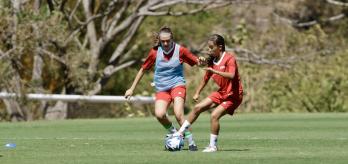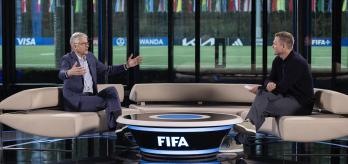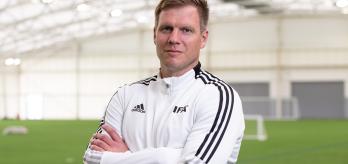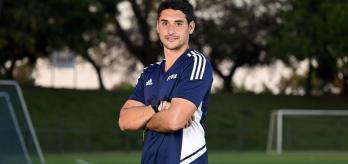Methodology
The intention: What is practised?
This attack v. defence exercise features a 1v1 scenario in which a defender is asked to engage with an attacker on the edge of the penalty area and force them wide, rather than allowing them to come inside. The defender should adopt a low, side-on body shape that means that they approach the attacker at an angle. The defender’s objective is to show the attacker out wide and avoid being beaten on the inside. The defender’s decision about whether to engage with the attacker or stay a short distance from them is a key when trying to force the attacker wide and away from danger.
The scale: For whom is this relevant?
This exercise revolves around the player scale, focusing predominantly on the defender’s ability to dictate the attacker’s movement in a 1v1 scenario. The drill is particularly relevant to players who operate in the defensive line between the attackers and the goal, specifically centre-backs. The scenario is applicable to defenders who take up a position on the edge of the penalty area with space in behind them when the ball carrier looks to attack at pace. Although the area of the pitch in which the exercise is performed means that the scenario typically involves centre-backs, it is applicable to any player who finds themselves in a 1v1 scenario in which they are tasked with preventing their opponent getting a shot off as they retreat towards their own goal.
The practice type: How is the practice designed?
This drill involves a 1v1 attack v. defence scenario that is designed to work on a defender’s body shape and timing with a view to preventing the ball carrier from progressing into dangerous areas. The exercise simulates a specific phase of the game. The 1v1 takes place on the edge of the penalty area and at an angle to goal. The angle of the attacker’s approach means that they have two choices: either to go inside or head out wide, with the latter being the objective of the exercise for the defender. The pass that is played into the attacker acts as a trigger for the defender to step out to press the attacker, whilst the mini-goal provides the defender with an objective if they win the ball.
Session plan
Organisation
-
Use two-thirds of a half-size pitch.
-
Place a full-size goal at the end of the exercise area furthest from the halfway line.
-
Position a goalkeeper in the goal.
-
Use 4 cones to mark out an area like shown in the graphic above that runs from the edge of the penalty area towards the halfway line.
-
In each of the 10m x 10m areas:
-
Position 3 players with a ball each at the cone situated at the corner of the penalty area furthest from the goal line.
-
Place a defender at the cone where the penalty arc intersects with the penalty area.
-
Position an attacker at the cone that is almost opposite and at a slight angle to the cone occupied by the defender.
-
Place a mini-goal between 2m and 3m behind the cone that is parallel to the edge of the penalty area furthest from the goal line, heading towards the halfway line.
-
Explanation
-
The first player in the queue at the cone occupied by 3 players plays a pass towards the cone where the attacker is stationed.
-
As the pass is played, the defender darts from their cone towards the attacker.
-
The attacker controls the ball before attempting to dribble past the defender with a view to finishing into the full-size goal.
-
The defender tries to win the ball. If they manage to do so, they attempt to pass it into the mini-goal.
-
Once the sequence is completed, the players rotate in a clockwise direction.
Key coaching points
Roles of coaches
-
First coach: explains the drill and encourages the defender to adopt the optimal body shape with a view to forcing the attacker wide.
-
Second coach: carries out the same role as the first coach at the drill performed on the opposite side of the penalty area.
-
Third coach: moves between the two drills, offering both the defenders and attackers support to help them to perform to their best.









